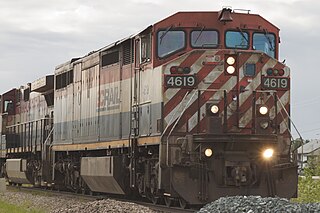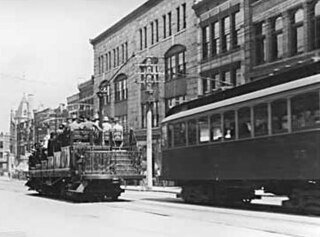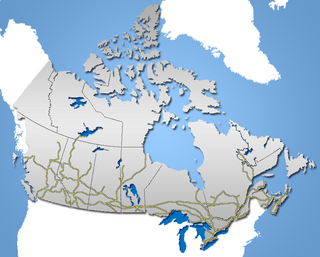Related Research Articles

British Columbia is the westernmost province of Canada. Situated between the Pacific Ocean and the Rocky Mountains, the province has a diverse geography, with rugged landscapes that include rocky coastlines, sandy beaches, forests, lakes, mountains, inland deserts and grassy plains. British Columbia borders the province of Alberta to the east; the territories of Yukon and Northwest Territories to the north; the U.S. states of Washington, Idaho and Montana to the south, and Alaska to the northwest. With an estimated population of over 5.6 million as of 2024, it is Canada's third-most populous province. The capital of British Columbia is Victoria, while the province's largest city is Vancouver. Vancouver and its suburbs together make up the third-largest metropolitan area in Canada, with the 2021 census recording 2.6 million people in Metro Vancouver.

The Canadian Pacific Railway, also known simply as CPR or Canadian Pacific and formerly as CP Rail (1968–1996), was a Canadian Class I railway incorporated in 1881. The railway was owned by Canadian Pacific Railway Limited, which began operations as legal owner in a corporate restructuring in 2001.
The Kettle Valley Railway was a subsidiary of the Canadian Pacific Railway (CPR) that operated across southern British Columbia, west of Midway running to Rock Creek, then north to Myra Canyon, down to Penticton over to Princeton, Coalmont, Brookmere, Coquihalla and finally Hope where it connected to the main CPR line.

New Westminster is a city in the Lower Mainland region of British Columbia, Canada, and a member municipality of the Metro Vancouver Regional District. It was founded by Major-General Richard Moody as the capital of the Colony of British Columbia in 1858 and continued in that role until the Mainland and Island colonies were merged in 1866. It was the British Columbia Mainland's largest city from that year until it was passed in population by Vancouver during the first decade of the 20th century.

BC Rail is a railway in the Canadian province of British Columbia.

Crowsnest Pass is a low mountain pass across the Continental Divide of the Canadian Rockies on the Alberta–British Columbia border.

Field is an unincorporated community of approximately 169 people located in the Kicking Horse River valley of southeastern British Columbia, Canada, within the confines of Yoho National Park. At an elevation of 1,256 m (4,121 ft), it is 27 km (17 mi) west of Lake Louise along the Trans-Canada Highway, which provides the only road access to the town. The community is named for Cyrus West Field of Transatlantic telegraph cable fame, who visited the area in 1884.

The British Columbia Electric Railway (BCER) was an historic railway which operated in southwestern British Columbia, Canada. Originally the parent company for, and later a division of, BC Electric Company, the BCER assumed control of existing streetcar and interurban lines in southwestern British Columbia in 1897, and operated the electric railway systems in the region until the last interurban service was discontinued in 1958. During and after the streetcar era, BC Electric also ran bus and trolleybus systems in Greater Vancouver and bus service in Greater Victoria; these systems subsequently became part of BC Transit, and the routes in Greater Vancouver eventually came under the control of TransLink. Trolley buses still run in the City of Vancouver with one line extending into Burnaby.

Canada has a large and well-developed railway system that primarily transports freight. There are two major publicly traded transcontinental freight railway systems, Canadian National (CN) and Canadian Pacific Kansas City (CPKC). Nationwide passenger services are provided by the federal crown corporation Via Rail, and three international services to the US by Amtrak. Three Canadian cities have commuter train services: in the Montreal area by Exo, in the Toronto area by GO Transit, and in the Vancouver area by West Coast Express. These cities and several others are also served by light rail or metro systems. Only one (Toronto) has an extensive streetcar (tram) system. Smaller railways such as Ontario Northland Railway also run passenger trains to remote rural areas. The Rocky Mountaineer and Royal Canadian Pacific provide luxury rail tours for viewing scenery in the Canadian Rockies as well as other mountainous areas of British Columbia and Alberta.

The Island Rail Corridor, previously the Esquimalt & Nanaimo Railway, is a dormant railway operation on Vancouver Island and is the only remaining railway there after the closure of the Englewood Railway in November 2017. The Island Corridor Foundation owns the former Esquimalt & Nanaimo Railway corridor. The railway line is 225 kilometres (140 mi) in length from Victoria to Courtenay, known as the Victoria Subdivision, with a branch line from Parksville to Port Alberni, known as the Port Alberni Subdivision, of 64 kilometres (40 mi), for a total 289 kilometres (180 mi) of mainline track. In 2006, the Island Corridor Foundation acquired the railway's ownership from the Canadian Pacific Railway.
The Columbia and Kootenay Railway (C&KR) was a historic railway operated by the Canadian Pacific Railway (CPR) in the West Kootenay region of British Columbia. This 25-mile (40 km) route, beside the unnavigable Kootenay River, linked Nelson on the west arm of Kootenay Lake with Robson at the confluence of the Kootenay River and the Columbia River near Castlegar.

Kicking Horse Pass is a high mountain pass across the Continental Divide of the Americas of the Canadian Rockies on the Alberta–British Columbia border, and lying within Yoho and Banff national parks. Divide Creek forks onto both sides of the Continental Divide.
The Southern Railway of British Columbia, branded as SRY Rail Link is a Canadian short line railway operating in southwestern British Columbia. The main facility is the port at Annacis Island with major import of cars, export of forestry products, and other shipments. The railway has interconnections with three Class I railroads, including Canadian Pacific Kansas City (CPKC), Canadian National (CN) and Burlington Northern Santa Fe (BNSF). It operates a fleet of 29 locomotives, mostly consisting of EMD GP-9 and SW900 locomotives. SRY also currently rosters 2 SD38-2s, an SD38AC and an SD35. Additionally, SRY formerly rostered 4 GMD1s. The railroad also operates a fleet 2,000 rail cars, hauling approximately 70,000 carloads per year. It operates around 123 miles (198 km) of track, 62 miles (100 km) of which is mainline track.

Founded in 1961, the West Coast Railway Association (WCRA) is a non-profit society dedicated to preserving British Columbia's railway heritage. The society operates the Railway Museum of British Columbia and the CN Roundhouse & Conference Centre located in Squamish, BC. The museum is home to over 90 pieces of vintage railway equipment and is the second largest railway museum in Canada, while the Conference Centre is a 21,000 sqft event venue.
Yahk Provincial Park is a provincial park located just south of Yahk, British Columbia, 70 kilometres south of Cranbrook, and 14.5 kilometres north of the Canada–United States border at Kingsgate in British Columbia, Canada.
Seton Portage Historic Provincial Park is a historic provincial park located in the community of Seton Portage, British Columbia, Canada. It was established on March 29, 1972 to commemorate the location of the first railway in the province of British Columbia.
Crown corporations in Canada are government organizations with a mixture of commercial and public-policy objectives. They are directly and wholly owned by the Crown.

The Canadian Pacific Railway Coast Service, also known as the British Columbia Coast Steamships (BCCS), was a division of Canadian Pacific Railway (CPR), which began operating Pacific coastal shipping routes in the late 19th century. The development of coastal passenger and cargo shipping routes extended from British Columbia to Alaska and to Seattle, Washington in the United States.

International was a stern-wheel driven steam boat that operated on Kootenay Lake in British Columbia from 1896 to 1908. International was owned by a Canadian subsidiary of the Great Northern Railway and was involved in sharp competition, including steamboat racing, with similar vessels owned by the Canadian Pacific Railway.

Kettle River Recreation Area is a 179 hectare provincial recreation area located inside a sharp S-bend of the Kettle River approximately 6 kilometres north of the community of Rock Creek, British Columbia. It is one of only two recreation areas in British Columbia, the other being Coquihalla Summit Recreation Area.